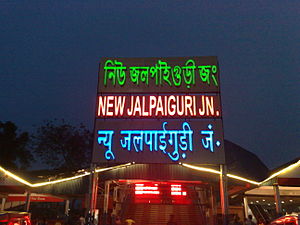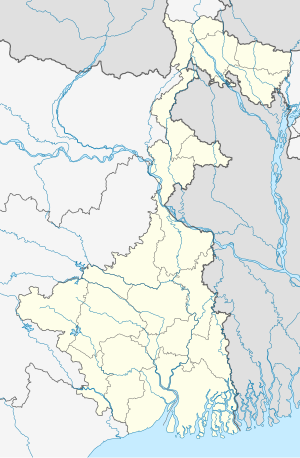New Jalpaiguri railway station
|
New Jalpaiguri Junction
নিউ জলপাইগুড়ি জংশন |
|
|---|---|
| Regional rail and Light rail station | |
 |
|
| Location | New Jalpaiguri Road, Bhaktinagar, Siliguri, Jalpaiguri district, West Bengal India |
| Coordinates | 26°40′57″N 88°26′38″E / 26.68250°N 88.44389°ECoordinates: 26°40′57″N 88°26′38″E / 26.68250°N 88.44389°E |
| Elevation | 114.00 metres (374.02 ft) |
| Owned by | Indian Railway |
| Operated by | Northeast Frontier Railway zone |
| Line(s) |
Darjeeling Himalayan Railway, Howrah–New Jalpaiguri line, Haldibari-New Jalpaiguri line, New Jalpaiguri–Alipurduar–Samuktala Road line Barauni-Guwahati line |
| Platforms | 9 (2 Narrow Gauge and 7 broad Gauge) |
| Construction | |
| Parking | Available |
| Other information | |
| Status | Functioning |
| Station code | NJP |
| Zone(s) | Northeast Frontier Railway zone |
| Division(s) | Katihar |
| History | |
| Opened | 1961 |
| Electrified | Under Construction |
| Location | |
|
|
New Jalpaiguri (more colloquially : NJP Station) is a railway station in the Indian state of West Bengal which serves the metropolis of Siliguri. It is the newest station in the city which was principally designed for the Indian broad gauge.
The partition of India in 1947 completely disrupted communication links in North Bengal and Assam with the southern parts of West Bengal. Earlier, the links were through the eastern part of Bengal, which became a part of Pakistan in 1947. Siliguri gained in importance as the gateway to North Bengal, Sikkim, Bhutan and Assam.
Around 1949, Siliguri Junction station, a new station north of the old Siliguri Town railway station, came up with several metre gauge lines converging on it. In addition there was the narrow gauge Darjeeling Himalayan Railway running from Siliguri Town station to Darjeeling via Siliguri Junction. The Assam Rail Link Project, completed in 1950, linked the railways in Assam, with a metre gauge line to Kishanganj. The line running across North Bengal, spanned the Teesta, Torsha, and Sankosh rivers.
In the early 1960s, Indian Railways started changing over from metre gauge to broad gauge and built a new 1,676 mm (5 ft 6 in) broad gauge station south of Siliguri Town station. Since the new station was located in Jalpaiguri district, it was named New Jalpaiguri. By 1964, New Jalpaiguri became the most important railway station in the area. It had both broad gauge (to Kishanganj and Barsoi, and to Siliguri town and Siliguri junction) and metre gauge (to Siliguri town and Siliguri junction) tracks. The Darjeeling Himalayan Railway narrow gauge track was extended from Siliguri town station to the new greenfield station. The metre gauge track from New Jaipaiguri to Siliguri town and Siliguri junction was later converted to broad gauge.
...
Wikipedia

